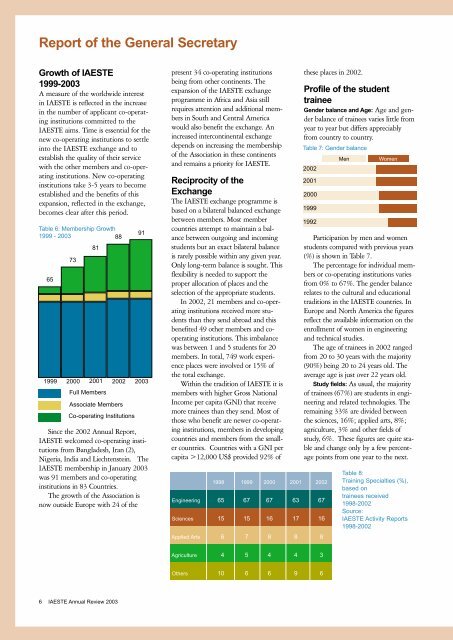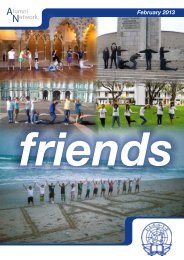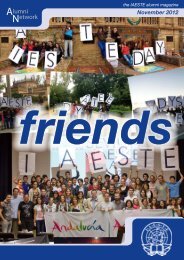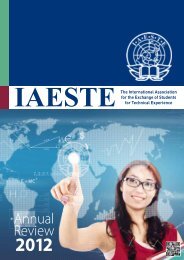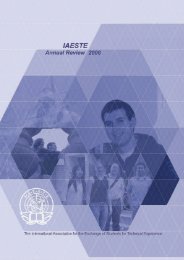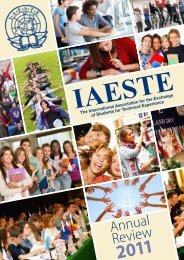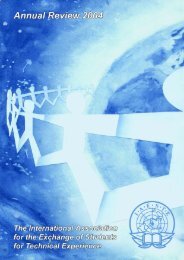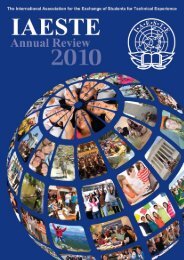IAESTE 2003 FULL MK
IAESTE 2003 FULL MK
IAESTE 2003 FULL MK
Create successful ePaper yourself
Turn your PDF publications into a flip-book with our unique Google optimized e-Paper software.
Report of the General Secretary<br />
Growth of <strong>IAESTE</strong><br />
1999-<strong>2003</strong><br />
A measure of the worldwide interest<br />
in <strong>IAESTE</strong> is reflected in the increase<br />
in the number of applicant co-operating<br />
institutions committed to the<br />
<strong>IAESTE</strong> aims. Time is essential for the<br />
new co-operating institutions to settle<br />
into the <strong>IAESTE</strong> exchange and to<br />
establish the quality of their service<br />
with the other members and co-operating<br />
institutions. New co-operating<br />
institutions take 3-5 years to become<br />
established and the benefits of this<br />
expansion, reflected in the exchange,<br />
becomes clear after this period.<br />
Table 6: Membership Growth<br />
1999 - <strong>2003</strong><br />
88<br />
65<br />
73<br />
81<br />
1999 2000 2001 2002 <strong>2003</strong><br />
Full Members<br />
Associate Members<br />
Co-operating Institutions<br />
Since the 2002 Annual Report,<br />
<strong>IAESTE</strong> welcomed co-operating institutions<br />
from Bangladesh, Iran (2),<br />
Nigeria, India and Liechtenstein. The<br />
<strong>IAESTE</strong> membership in January <strong>2003</strong><br />
was 91 members and co-operating<br />
institutions in 83 Countries.<br />
The growth of the Association is<br />
now outside Europe with 24 of the<br />
6 <strong>IAESTE</strong> Annual Review <strong>2003</strong><br />
91<br />
present 34 co-operating institutions<br />
being from other continents. The<br />
expansion of the <strong>IAESTE</strong> exchange<br />
programme in Africa and Asia still<br />
requires attention and additional members<br />
in South and Central America<br />
would also benefit the exchange. An<br />
increased intercontinental exchange<br />
depends on increasing the membership<br />
of the Association in these continents<br />
and remains a priority for <strong>IAESTE</strong>.<br />
Reciprocity of the<br />
Exchange<br />
The <strong>IAESTE</strong> exchange programme is<br />
based on a bilateral balanced exchange<br />
between members. Most member<br />
countries attempt to maintain a balance<br />
between outgoing and incoming<br />
students but an exact bilateral balance<br />
is rarely possible within any given year.<br />
Only long-term balance is sought. This<br />
flexibility is needed to support the<br />
proper allocation of places and the<br />
selection of the appropriate students.<br />
In 2002, 21 members and co-operating<br />
institutions received more students<br />
than they send abroad and this<br />
benefited 49 other members and cooperating<br />
institutions. This imbalance<br />
was between 1 and 5 students for 20<br />
members. In total, 749 work experience<br />
places were involved or 15% of<br />
the total exchange.<br />
Within the tradition of <strong>IAESTE</strong> it is<br />
members with higher Gross National<br />
Income per capita (GNI) that receive<br />
more trainees than they send. Most of<br />
those who benefit are newer co-operating<br />
institutions, members in developing<br />
countries and members from the smaller<br />
countries. Countries with a GNI per<br />
capita >12,000 US$ provided 92% of<br />
these places in 2002.<br />
Profile of the student<br />
trainee<br />
Gender balance and Age: Age and gender<br />
balance of trainees varies little from<br />
year to year but differs appreciably<br />
from country to country.<br />
Table 7: Gender balance<br />
2002<br />
2001<br />
2000<br />
1999<br />
1992<br />
1998 1999 2000 2001 2002<br />
Engineering 65 67 67 63 67<br />
Sciences 15 15 16 17 16<br />
Applied Arts 6 7 8 8 8<br />
Agriculture 4 5 4 4 3<br />
Others 10 6 6 96<br />
Men<br />
Women<br />
Participation by men and women<br />
students compared with previous years<br />
(%) is shown in Table 7.<br />
The percentage for individual members<br />
or co-operating institutions varies<br />
from 0% to 67%. The gender balance<br />
relates to the cultural and educational<br />
traditions in the <strong>IAESTE</strong> countries. In<br />
Europe and North America the figures<br />
reflect the available information on the<br />
enrollment of women in engineering<br />
and technical studies.<br />
The age of trainees in 2002 ranged<br />
from 20 to 30 years with the majority<br />
(90%) being 20 to 24 years old. The<br />
average age is just over 22 years old.<br />
Study fields: As usual, the majority<br />
of trainees (67%) are students in engineering<br />
and related technologies. The<br />
remaining 33% are divided between<br />
the sciences, 16%; applied arts, 8%;<br />
agriculture, 3% and other fields of<br />
study, 6%. These figures are quite stable<br />
and change only by a few percentage<br />
points from one year to the next.<br />
Table 8:<br />
Training Specialties (%),<br />
based on<br />
trainees received<br />
1998-2002<br />
Source:<br />
<strong>IAESTE</strong> Activity Reports<br />
1998-2002


